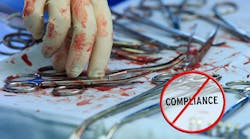The single, most important responsibility for all healthcare providers is to ensure patient safety. A key element of that responsibility is to minimize the risk of an instrument that is still contaminated after reprocessing being returned to surgery which could cause patient harm. We’ve always been told that “If it’s not clean, it can’t be sterile." The more accurate statement is that “If it’s not clean, it can’t be safe!”
Data from the Centers for Disease Control (CDC) indicate that surgical infections cost an average of $57,000 per occurrence, add extra days of hospitalization and increase a patient’s chance of being placed in the ICU by 60%. Patients who contract a surgical infection are five times more likely to be readmitted to the hospital after their surgical procedure. An even greater tragedy is the fact that patients who acquire a surgical infection suffer twice the incidence of mortality. Surgical infections are the cause of over 30,000 deaths annually.1
The first step for a healthcare facility to minimize their patients’ risk of contracting a surgical infection caused by a difficult, if not impossible to clean instrument, is to only use instruments whose cleaning and sterilization Instructions For Use (IFUs) have been validated. The validation must be done by independent laboratory testing using FDA and AAMI testing protocols. If your instruments’ IFUs have not been validated, you cannot ensure that they are clean, sterile and moisture-free after reprocessing. In the absence of independent laboratory validated IFUs, you can follow the manufacturer’s non-validated IFU and still be returning a contaminated instrument to surgery.
Defining ‘Validated’
When it comes to IFUs, the most misused and misunderstood word in our industry today is the word ‘validated.’ A lot of reusable instrument manufactures state that their IFUs have been validated, but when you read the fine print of their IFUs, all they actually say is that their instruments were sterilized at a given temperature, time and pressure. When the instruments emerged from the sterilizer, the sterilization indicator showed that sterilization conditions were present. The manufacture never tested whether or not the instruments were free of bioburden and biofilm after cleaning that was done by following their published cleaning IFUs.
Per an IFU report in Healthcare Purchasing News, “A major limitation with many manufacturers’ IFUs is that they require a CS/SPD professional to visually inspect an instrument after cleaning for bioburden and/or biofilm prior to sterilization. For some complex instruments that means disassembling them to inspect and clean. But the dirty little secret is that this residue is invisible to the naked eye — making the task physically impossible.”2
According to ANSI/AAMI ST79:2017/(R)2022 “Visual inspection alone may not be sufficient for assessing the efficacy of the cleaning process.” ST79 recommends “The use of methods3 that are able to measure organic residues that are not detectable using visual inspection should be considered in facility cleaning policy and procedures.”
When it comes to the need for validated IFUs, the FDA states, “As it is difficult for the health care workers responsible for reprocessing reusable devices to assess the amount and resistance of microbial contamination on the devices to be reprocessed, product labeling, professional practices, and institutional infection control procedures help guide the persons who are responsible for reprocessing devices.” 4
The FDA goes on to point out, “Safe reprocessing of reusable medical devices for the next patient can only be done by carefully adhering to validated reprocessing instructions.”5
Without validated cleaning and sterilization IFUs, reprocessing personnel are put in an untenable situation. They are held accountable for returning clean, sterile, moisture-free instruments to surgery and yet, they’re dealing with instruments who’s cleaning IFUs have never been validated and even worse, they are having to rely on visual inspection which cannot detect microscopic bioburden, much less biofilm.
The second step for a healthcare facility to take to minimize their patients’ risk of contracting a surgical infection is to gain more knowledge about validated IFUs and why they need to be part of the facility’s infection prevention program. A good place to find a wealth of information on IFUs and the need for validation can be found online at #IFUcan http://www.linkedin.com/showcase/ifucan/. Co-founded6 by a veteran group of healthcare sterile processing and distribution (SPD) advocates, experts and observers, #IFUcan is dedicated to exploring and promoting the use of validated IFUs to improve the quality of patient care.
Reusable medical devices and instruments generally include multiple IFUs, which are step-by-step narratives on how to reprocess (clean, disinfect and sterilize) these products safely and thoroughly. The challenge? What if the IFUs fall short of meeting those expectations? Who then remains at fault when a patient experiences harm?
Protecting patients from harm caused by a contaminated instrument starts by following manufacturers’ published cleaning and reprocessing IFUs. Even more important is to demand IFUs that have been validated by independent laboratory testing using AAMI and FDA test protocols. By using instruments with validated IFUs healthcare professionals can have the documented assurance of providing clean, sterile, moisture-free instruments for every patient, every time.
References:
1 CDC publication “Guideline for Prevention Of Surgical Site Infection, Hospital Infections Program, National Center For Infectious Diseases.”
2 “Validated? It’s Complicated” by Kara Nadeau, HPN, April 2017
3 See AAMI ST79 Annex D for available methods.
4 FDA publication “Reprocessing Medical Devices in Health Care Settings: Validation Methods and Labeling Guidance for Industry and Food and Drug Administration Staff.” March 17, 2015
5 Ibid FDA
6 Ralph Basile, vice president, Healthmark Industries Company, Inc., Fraser, MI.
Abed Moiduddin, vice president, Novo Surgical Inc., Oak Brook, IL.
Rick Dana Barlow, president, Wingfoot Media Inc.; co-founder and executive director, Bellwether League Foundation; and former senior editor, Healthcare Purchasing News, Schaumburg, IL
James Schneiter, founder, owner and president, America’s Medsource Inc., Kenosha, WI.
Prior to his retirement in 2018, James Schneiter had been the founder, owner and president of America’s MedSource Inc., which designed, developed, licensed and marketed a variety of implantable vascular devices, laparoscopic devices and neurosurgical instruments. Schneiter has five decades of experience in medical device design and production, is a recognized expert in instructions for use (IFU) and independent laboratory IFU validation studies and is a co-founder of #IFUcan, an online community that examines and explores the world of manufacturer IFUs and provides thought-provoking content on past and current practices and procedures. Schneiter can be reached at [email protected].





